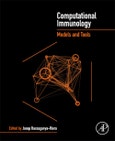Computational Immunology: Models and Tools encompasses the methodological framework and application of cutting-edge tools and techniques to study immunological processes at a systems level, along with the concept of multi-scale modeling.
The book's emphasis is on selected cases studies and application of the most updated technologies in computational modeling, discussing topics such as computational modeling and its usage in immunological research, bioinformatics infrastructure, ODE based modeling, agent based modeling, and high performance computing, data analytics, and multiscale modeling.
There are also modeling exercises using recent tools and models which lead the readers to a thorough comprehension and applicability.
The book is a valuable resource for immunologists, computational biologists, bioinformaticians, biotechnologists, and computer scientists, as well as all those who wish to broaden their knowledge in systems modeling.
Please Note: This is an On Demand product, delivery may take up to 11 working days after payment has been received.
The book's emphasis is on selected cases studies and application of the most updated technologies in computational modeling, discussing topics such as computational modeling and its usage in immunological research, bioinformatics infrastructure, ODE based modeling, agent based modeling, and high performance computing, data analytics, and multiscale modeling.
There are also modeling exercises using recent tools and models which lead the readers to a thorough comprehension and applicability.
The book is a valuable resource for immunologists, computational biologists, bioinformaticians, biotechnologists, and computer scientists, as well as all those who wish to broaden their knowledge in systems modeling.
Please Note: This is an On Demand product, delivery may take up to 11 working days after payment has been received.
Table of Contents
1. Introduction to Computational ImmunologyOverview
Modeling tools and techniques
Use Cases Illustrating the Application of Computational Immunology Technologies
2. Computational Modeling
Overview on Computational Modeling
Translational Research Iterative Modeling Cycle
- Information and knowledge extraction from the Literature - Collect new data and data from public repositories - Model Development - In silico Experimentation - Validation of Computational Hypotheses and New Knowledge - Considerations on Computational Modeling Technologies - Computational Modeling Tools for Immunology and Infectious Disease Research
Concluding Remarks
3. Use of Computational Modeling in Immunological Research
Introduction
Computational and mathematical modeling of the immune response to Helicobacter pylori
- Inflammatory bowel disease - ODE model of CD4+ T cell differentiation - T follicular helper cell differentiation
Concluding remarks
4. Immunoinformatics cybernfrastructure for modeling and analytics
Introduction
Web Portal
LabKey-based Laboratory Information Management System
Public Repositories: ImmPort
Global gene expression analysis
High Performance Computing Environment
HPC infrastructure for ENISI MSM modeling
CyberInfrastructure for NETwork science (CINET)
Pathosystems Resource Integration Center (Patric)
Clinical Data Integration
Concluding Remarks
5. Ordinary Differential Equations (ODE) based Modeling
Introduction
ODE based modeling pipeline
- Model development - Model Calibration - Deterministic simulations - Sensitivity analysis - Model driven hypothesis generation
Case studies: CD4+ T cell differentiation model
Concluding Remarks
6. Agent-Based Modeling and High Performance Computing
Introduction and basic definitions
Related work
Technical implementation of ENISI
Formal Representation of ENISI
Agent Based Modeling using ENISI
Calibration and validation of the preliminary model
Sensitivity Analysis for ABM
Scaling the sensitivity analysis calculations
Scalability and Performance
Modeling Study investigating immune responses to H. pylori
- Use case: Predictive computational modeling of the mucosal immune responses during H. pylori infection
Concluding remarks
7. From Big Data Analytics and Network Inference to Systems Modeling
Introduction
Big Bata drives Big Models
- Experimental planning and power analysis - RNA-Seq analysis pipeline - Read summarization - Differential expression analysis - Time series data - Unsupervised high-resolution clustering
Tools, techniques and pipelines
- RNA-Seq analysis in the cloud - RNA Rocket at the PAThosystems Resource Integration Center - Network inference and analytics - Supervised Machine learning methods - NetGenerator - Adaptive Robust Integrative Analysis for finding Novel Association (ARIANA) - Case study: Reconstructing the Th17 differentiation networkConcluding remarks
8. Multiscale Modeling: Concepts, Technologies, and Use Cases in Immunology
Introduction
Multiscale modeling concepts and techniques
- Modeling Technologies and Tools - From Single Scale to Multiscale Modeling
Sensitivity analysis
- Global versus local sensitivity analysis - Sparse experimental design for sensitivity analysis - Temporal significance of modeling parameters - Sensitivity analysis across scales
Multiscale Modeling of Mucosal Immune Responses
- The scales of ENISI platform - Challenges and opportunities
Case Study
- Modeling mucosal immunity in the Gut - Multiscale modeling of mucosal immune responses
Concluding remarks
9. Modeling exercises
Modeling tools
Models
- Computational model of immune responses to Clostridium difficile infection - Computational model of the 3-node T helper type 17 model - Computational model of the 9-node Th1/Th17/Treg model
Model complexity and model-driven hypothesis generation
Concluding remarks








